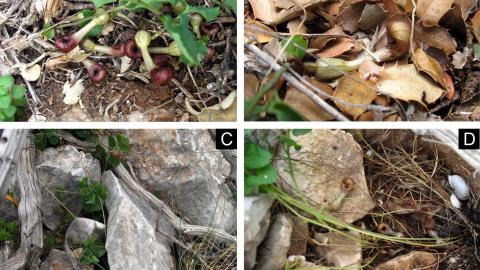First-of-its-kind flower smells like dead insects

Credit: T. Rupp, B. Oelschlägel, K. Rabitsch et al.
- Many plants use some kind of mimicry to attract pollinators.
- After bees, flies are the second most important pollinator on the planet.
- Plants that emit smelly odors usually try to mimic dead vertebrates, but Aristolochia microstoma is the first known plant to smell like dead insects.
Somewhere between four and six percent of all flowering plants use some form of deception to lure in pollinators. For instance, they can appear to be a source of food or even a potential mate. The pollinators, being unable to detect the illusion, are drawn in and rewarded with little more than a dusting of pollen. Research into the deceptive nature of these plants and how they evolved isongoing.
One of these studies, recently published inFrontiers in Ecology and Evolution, sheds light on the deception strategy used by the plant Aristolochia microstoma. Uniquely, this flower lures pollinating insects by emitting the stench of dead invertebrates.
Insects head toward the smell of other dead insects

A. microstoma is a purple-brown flower found in Greece. It typically blooms close to the ground, as seen in the above image. This is unusual, as most Aristolochia species have bold and easily seen flowers well above the ground. Additionally, this flower tends to be horizontally oriented, as opposed to the more vertical structure of similar species’ flowers. A. microstoma is known to smell like decay, often to the displeasure of humans walking near it.
Pollinators stumble into the flower and — not unlike Hotel California — find themselves unable to leave. Their movements pollinate the plant. Later, they are covered in pollen from the male part of the flower before being released. The cycle then repeats as the insects fall for the same tricksagain.
Enter the coffin fly
To learn more about the flower’s strange traits and how that relates to its pollination, the authors collected 1457 flowers from three sites in Greece, two on the Peloponnese and one west of Athens. Of the samples, 72 percent were in the first, female stage of blooming. (These flowers go through two stages, first female, then male.) These samples contained 248 arthropods, but only a collection of Megaselia scalaris — also known as coffin flies — were found carrying pollen, suggesting that it is a typical pollinator of the flower.
How fitting, given the smell.
Before this study, it was presumed that A. microstoma was pollinated by ground dwelling pollinators, such as ants. It isn’t too surprising that flies would be a primary pollinator, though. After bees, flies are the second most important pollinator on theplanet. Many plants have scents and appearances that seem to be trying to attractflies. Unsurprisingly, few of them are known for smelling pleasant.
Fool me once, fool me twice
Between the smell and the location, it is possible the flower simulates a food source or breeding area for the flies well enough to fool them repeatedly.
Additionally, the researchers used gas chromatography to analyze the chemicals and compounds that give the flowers their unique scent. Sixteen compounds were found, including sulfur- and nitrogen-containing molecules, both likely contributors to the powerful odor of the plant.
These compounds included the alkylpyrazine 2,5-dimethylpyrazine. This compound has a unique aroma — decaying beetles, mouse urine, and roasted nuts — so it is unlikely to be used as a perfume. It also can be found in cigarettes and is occasionally used as a food additive for flavor purposes.
Few plants produce this compound, leading the authors to conclude that the plant is producing it to attract specific pollinators. They also mention that the decaying remains of vertebrate animals don’t produce this compound either, further strengthening the idea that the plant is trying to smell like decayinginsects.
Study co-author Stefan Dötterl from the Botanical Gardens at the Paris-Lodron University of Salzburg explained, “Our results suggest that this is the first known case of a flower that tricks pollinators by smelling like dead and rotting insects rather than vertebrate carrion.”
The authors note that the next area of study is to see how fond potential pollinators are of this particular odor. Studies hoping to answer that question are already underway. Let us hope the bugs like it, as it seems nobody else does.





